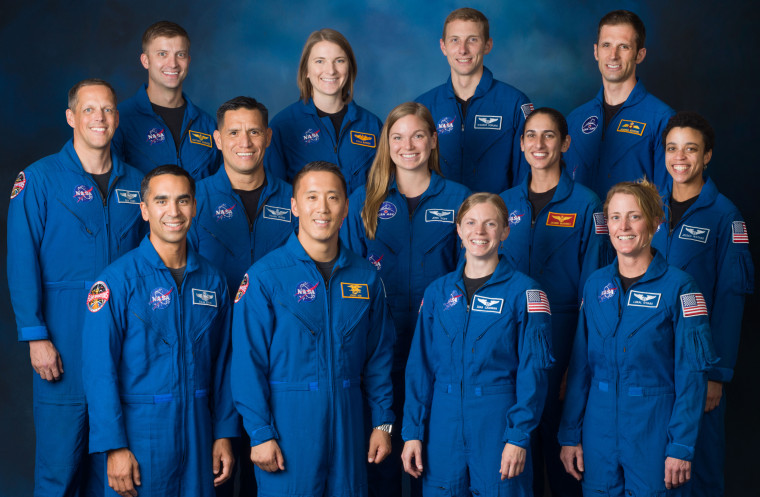HOUSTON — NASA's newest astronauts are ready to come out of their shells and walk on the moon.
Nicknamed the "Turtles," the space agency's 22nd class of astronauts graduated from basic training and became eligible for spaceflight assignments on Friday. A ceremony held at the Johnson Space Center in Houston honored the 11 Americans, together with two Canadian Space Agency (CSA) astronauts who trained with them.
The new class, which includes six women and seven men, expands NASA's active corps to 48 members. CSA has now doubled its ranks to four with the graduation of this, its fourth group of astronauts.
Related: Welcome, Space Cadets! Meet NASA's 2017 Astronaut Class
Selected in 2017 from record-setting pools of candidates, the new astronauts are the first to receive their astronaut pins under NASA's Artemis program, which aims to land the first woman and next man on the moon by 2024. The class members may be some of the first astronauts to fly to the moon since the Apollo program 50 years ago, or they may be assigned to launch to the International Space Station aboard U.S. commercial crew spacecraft.
To arrive at this point, the Turtles (nicknamed such by the prior astronaut class, the "8 Balls," after a joke about turtles on fenceposts), were put through more than two years of basic training. They took part in neutral buoyancy underwater dives to learn how to spacewalk, were sent out on geology field trips, received training in operating robotics and were taught wilderness survival skills. They also became proficient in space station systems, took Russian language classes, experienced weightlessness on parabolic aircraft flights and flew NASA's T-38 supersonic jets.
The NASA members of the Turtles include:
Kayla Barron, a 32-year-old U.S. Navy lieutenant who served as a submarine warfare officer and the flag aide to the superintendent of the U.S. Naval Academy.
Zena Cardman, 32, a marine biologist who studied microorganisms in subsurface environments, ranging from caves to deep sea sediments, on multiple expeditions to Antarctica and NASA analog missions in British Columbia, Idaho and Hawaii.
Raja Chari, a 42-year-old U.S. Air Force colonel who served as the commander of the 461st Flight Test Squadron and director of the F-35 Integrated Test Force at Edwards Air Force Base (AFB) in California.
Matthew Dominick, 38, a U.S. Navy lieutenant commander who served on the USS Ronald Reagan aircraft carrier as department head for a strike fighter squadron.
Bob Hines, 44, a U.S. Air Force lieutenant colonel who flew as a Federal Aviation Administration (FAA) flight test pilot and NASA research pilot at Johnson Space Center.
Warren "Woody" Hoburg, 34, a commercial pilot and search and rescue unit member who led a research group as an assistant professor of aeronautics and astronautics at the Massachusetts Institute of Technology.
Jonny Kim, a 36-year-old Navy SEAL, who completed more than 100 combat operations before becoming a physician resident in emergency medicine at Massachusetts General Hospital in Boston.
Jasmin Moghbeli, a 36-year-old U.S. Marine Corps major who tested H-1 helicopters and served as the quality assurance and avionics officer for Marine Operational Test and Evaluation Squadron 1 in Yuma, Arizona.
Loral O'Hara, 36, a research engineer at Woods Hole Oceanographic Institution in Massachusetts, where she worked on deep-ocean research submersibles and robots.
Francisco "Frank" Rubio, a 44-year-old U.S. Army lieutenant colonel who was a Blackhawk helicopter pilot and served as a surgeon for the 3rd Battalion of the 10th Special Forces Group at Fort Carson, Colorado.
Jessica Watkins, 31, worked at NASA's Ames Research Center at Moffett Field, California, the Jet Propulsion Laboratory in Pasadena, California, and California Institute of Technology, where she collaborated on NASA's Mars Science Laboratory rover, Curiosity.
The CSA members of the Turtles are:
Joshua Kutryk, a 37-year-old Royal Canadian Air Force lieutenant colonel who worked as an experimental test pilot and fighter pilot, leading the unit responsible for the operational flight-testing of fighter aircraft in Canada.
Jennifer "Jenni" Sidey-Gibbons, 31, an engineer who conducted research on flame propagation in microgravity in collaboration with CSA and as an assistant professor in combustion at the University of Cambridge.
The Turtles originally included a 14th candidate, Robb Kulin, a private pilot who worked as the senior manager for flight reliability at SpaceX. Kulin resigned from NASA in 2018 "for personal reasons." Kulin is now director of engineering for Firefly Aerospace, a Texas-based launch services company for small payloads.
NASA has been training astronauts since 1959 and the selection of the original Mercury 7 pilots. Including the Turtles, the U.S. space agency has qualified 347 men and women for spaceflight and has trained 34 professional astronauts from Canada, Japan and the European Space Agency (ESA).
Click through to collectSPACE to see the Turtles' 22nd astronaut class patch.
- What It's Like to Become a NASA Astronaut: 10 Surprising Facts
- Check Out NASA's New Artemis-Generation Spacesuits (Video)
- Who Will Be the First Woman on the Moon?
Follow collectSPACE.com on Facebook and on Twitter at @collectSPACE. Copyright 2020 collectSPACE.com. All rights reserved.
